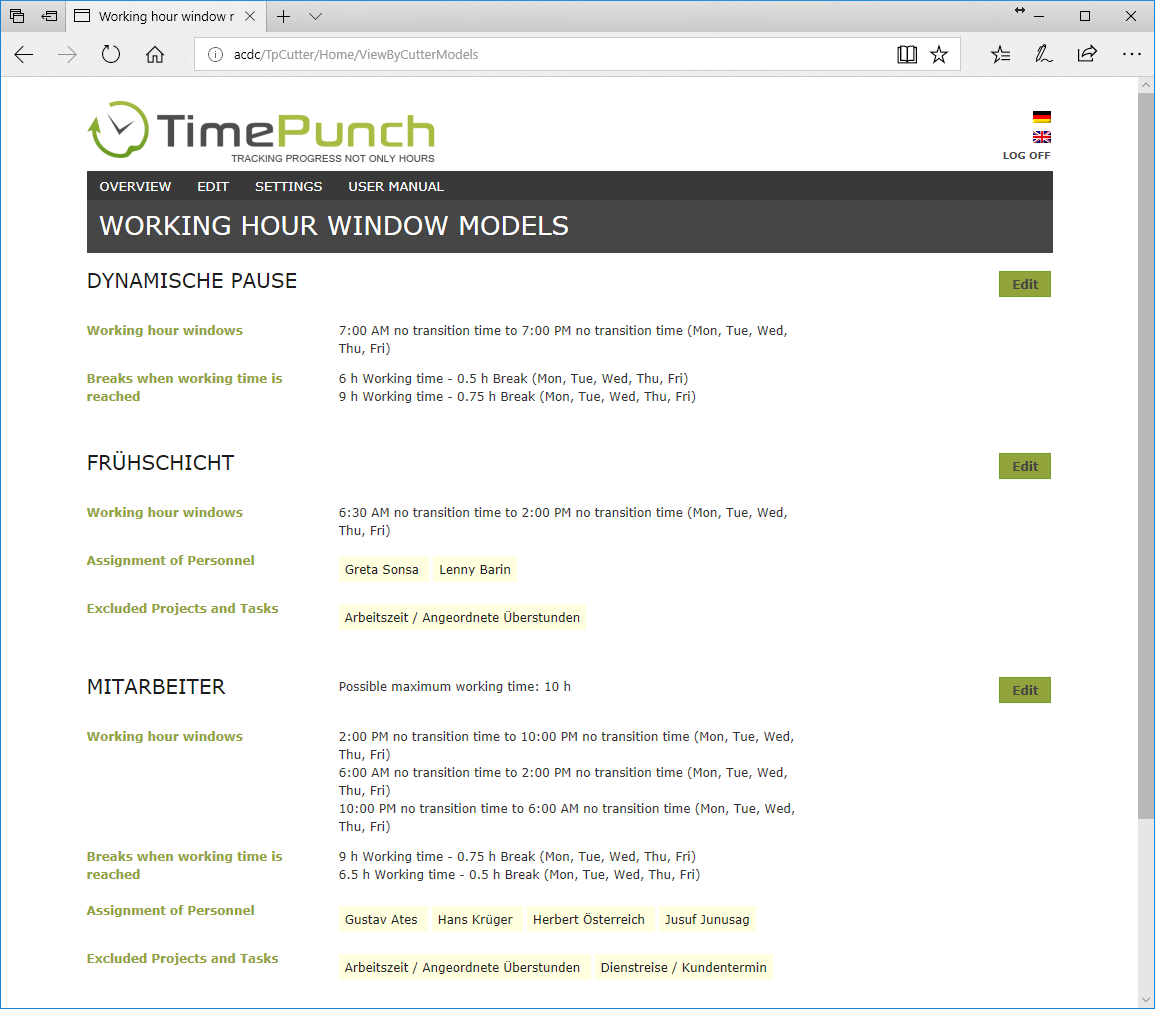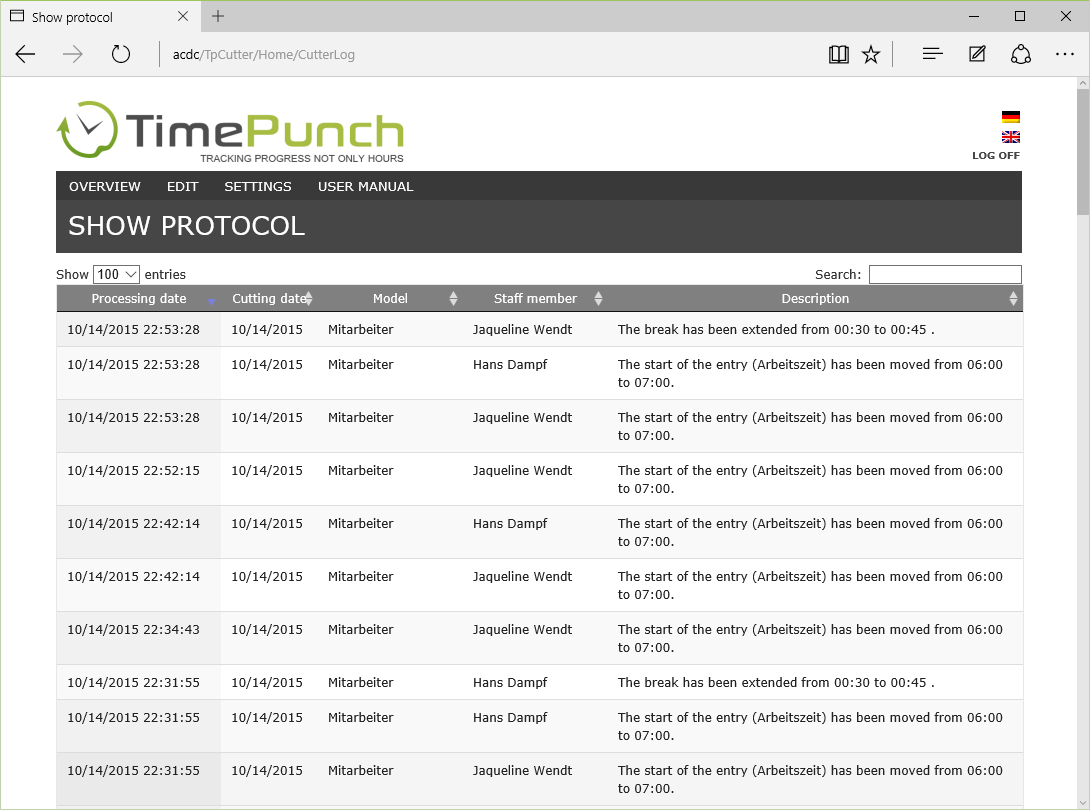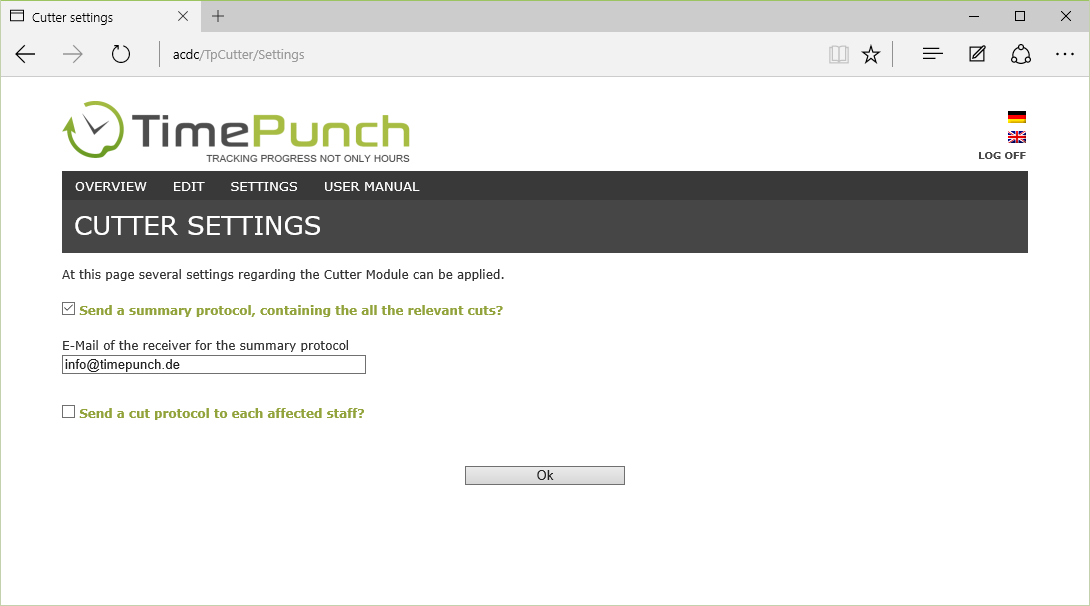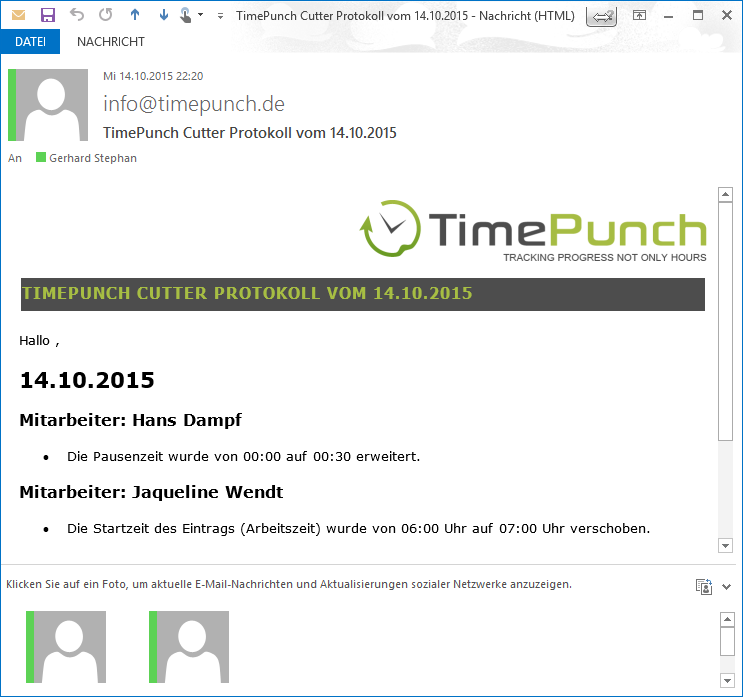Usage
The following pages describe the usage of the TimePunch Cutter Module.
Start of the Cutter Module
The Cutter Module can be started by clicking onto the symbol “scissors“.

After clicking the icon, the TimePunch Cutter Module website will open with the URL:
http://{ServerName}/TpCutter
The employee must log into the system with his credentials for TimePunch. In order to use the cutter module, the employee profile must be protected with a password.

Working hour window model
The working hour window models define under which circumstances the staff member can record the working times. E.g. it could be possible to define a restriction that the staff member cannot sign in before a certain time is reached, or one is forced to take special break times.
This can be defined in the so called working hour window model. After the start of the TimePunch Cutter Module a list with the already created working hour window models will be displayed.

Using the button “Create new working hour window model” a new working hour window model can be created. Modifying the working hour window model can be done by invoking the button “Edit”.
Create or modify a working hour window model
At the dialog to modify the working hour window model, the data can be amended.

Name of the working time model
The working time model requires a unique name that is also used for logging, and the working time model requires a unique name that is also used for logging.
Is the maximum working time defined?
By defining the maximum working time, you can prevent the employee from posting more hours than agreed.
Should the working time be reduced to the planned working time?
This setting determines whether the maximum working time is limited to the target time defined in the working time model. This setting prevents the booking of overtime.
Hint:
If this setting is activated, employees no longer have the option of compensating for absence times through overtime.
Times are not deleted, only marked as deleted.
The time entries are marked as deleted. This means that the original entries still exist but are changed so that the time is no longer booked as working time.
In this way, the booked times can be reconstructed even after the reduction.
Proportional break at the end of working time
If this item is ticked, a break at the end of the working time is only calculated on a pro rata basis.
Example: An employee is obliged to take a 30-minute break after 6 hours of work.
If he works 10 minutes for 6 hours, the time is reduced by 30 minutes. However, if the break is only calculated "pro rata", then the working time is only reduced by 10 minutes.
Break calculation occurs
There are two ways of calculating the mandatory breaks.
Simplified
In this case, all the employee's breaks that occurred on one day are summed and checked to see whether they correspond to the minimum break entered in the "Mandatory break after working time" field.
If the employee's entered break is smaller than the mandatory break, the system adds the break time until the mandatory break.
According to the German working time law
In this setting, TimePunch checks whether the employee has entered the mandatory break within the set working time (for example, 6 hours). Even if the employee has booked a break himself after 6:30 minutes, for example, the break is added within the 6 hours, since the law does not allow him to be employed for longer than this time without a rest break.
Break is considered, with a minimum length of
This setting determines the break time duration from which the break is counted as a resting break. According to the German working time act, rest periods are only counted as such after 15 minutes. Breaks below these are work interruptions which have no influence on the minimum break set.
Example:
If 15 minutes are entered for this setting and the employee takes a smoking break of 2 x 5 minutes, the employee is given a 30-minute break at the end of the day - since the two 5-minute breaks do not contribute to the employee's recovery according to the law.
Recording precision
The rounding precision determines how and whether the start of the working time (first entry) and the end of the working time (last entry) are rounded. Without rounding (to the minute), the booking of the employees is taken over 1 to 1.
The fields "Grace period at logon" and "Grace period at logoff" determine up to how many minutes employees are rounded in a friendly way; and from when an employer-friendly rounding takes place.
Example: The time should be rounded to 10 minutes. The grace period at logon is 3 minutes.
Case 1: Employees arrive 2 minutes late for work. In this case, employee-friendly rounding takes place: 8:02 becomes 8:00.
Case 2: Employees arrive 5 minutes late for work. In this case, employer-friendly rounding is applied: 8:05 becomes 8:10.
Employee assignment
This determines which employees are affected by the working time model.
Unpaid overtime
You can use the selection list to determine whether unpaid overtime per day applies to employees. Depending on your selection, up to 50 minutes of unpaid overtime per day can be defined here.
Frame working hours / shifts
Different shift times or framework working times can be stored. Depending on the employee's actual booking, the appropriate working time model is selected, and the employee's working time is adjusted accordingly.
The transition period at the start and end of the respective shift defines the period up to which the working time model is used.
Without a transitional period, this means that the framework working hours are valid all-day long.
Example:
Frame time model from 8:00 without transition time to 17:00 (+30 minutes)
- booking period from 7:50 to 16:30 is 8:00 to 16:30
- booking period from 7:45 to 17:10 will be 8:00 to 17:00
- booking period from 7:30 to 17:45 will be 8:00 to 17:45
Breaks with start and end time
If there are mandatory breaks in the company, these can be stored with start and end time.
Mandatory breaks after working time 1
Here mandatory breaks are defined which become necessary after a certain working time.
Excluded projects and activities
Working times booked for the excluded projects and activities are not affected by the reductions. For example, ordered overtime hours could be permitted as an exception.
Cutting the working hour window model
The working times of the previous day gets automatically cut each night (normally at 1 o´clock) for all staff members.
Therefore, no manual start of the cutting process is necessary, because it will happen automatically each night.
In exceptional cases a manual start of the cutting process can be welcome. This is for example the case, if the working times must be cut retroactively. Using the menu item “Cut working hour window model” the process can be started manually.

Attention: This process can’t be reverted. The working times will be cut as defined in the working time model.
Because this process can take longer, the cutting process will only be started. The result of the cutting process will be displayed in the cutting protocol. Manually updating the protocol page might be necessary.
**
**
Cutting protocol
By using the menu item “Overview / Show protocol” the current cutting protocol of the last 14 days will be displayed. Using the filter feature the protocol can be filtered for members and date.

Settings
At the SETTINGS page one can define whether and which employees will receive a log of cutting activity via email.

It can be defined whether to send a mail with all cuts to central mail recipients. If the daily cutting process produces changes, then they will sent to address the specified email.
Alternatively the log for each by the cuts affected staff member can be sent. It is however necessary that the correct email address of the employee is stored within the TimePunch staff profile.

Example of cutting protocol that is shipped in every day when there are changes.
End of the Document
- Mandatory breaks can already be stored in the standard version of TimePunch. For a detailed description of the differences, see the corresponding chapter.↩